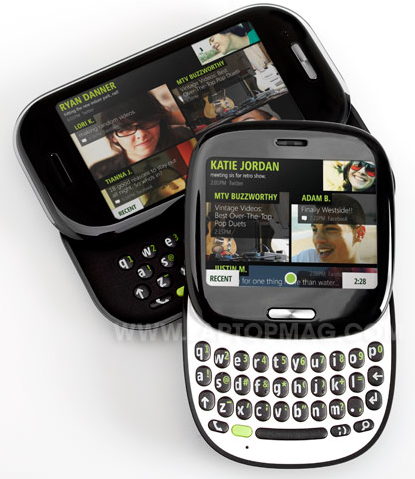Microsoft Kin One and Kin Two Verdict: Wait for Windows Phone 7
The Kin One and Kin Two from Microsoft and Verizon Wireless are designed to let youngsters share TMI with the world. Both not-so-smart phones integrate Twitter, Facebook, Windows Live, and MySpace so you can get your contacts and status updates all in one place. But while some of the ideas behind these devices have merit--including a website where are all your images and videos are automatically stored--ultimately both Kins are half-baked and overpriced.
What differentiates the Kin One and Kin Two from other phones are three features in the bare-bones OS: Kin Loop (where you get status updates), Kin Spot (multimedia sharing), and Kin Studio (cloud-based storage). In addition, the phones feature the Zune HD interface for music and video, and can even sync with iTunes, like the Palm Pre once did.
The Kin One will be available for order on May 6 for $79.99 after $100 mail-in-rebate, and the Kin Two will be available for order the same day for $149.99 after $100 mail-in-rebate. The problem is that Verizon charges $30 per month for data, the same price you'd pay for much more capable and versatile smart phones like the Palm Pre and Motorola Droid. Let us count the ways these handsets disappoint.
First, let's start with the social-networking features common to both phones:
Kin Loop is basically where all the action happens: status updates from Twitter, Facebook and MySpace are aggregated onto your home screen so you can see what all your friends are up to. From there, you can also set your status updates and decide whether all of your social networks get to see it, or select the ones that you want. The younger crowd may like the interface, but we found it busy and confusing.
When you swipe to the left you'll see a bunch of other panels, including Feeds, which better organizes the latest updates from the services you use. Unfortunately, you can't really do much other than read your feed and post updates. For example, in the Twitter "app" you can't see your @replies in a separate field or search. And you can't send direct messages or retweet. Seriously.
Swiping to the right from the home screen launches a Favorites page that shows your favorite people. However, we couldn't move the contacts around, and you'll only see a phone number for a given person if they publish it to the service used to suck in their contact info. Those services do not include Yahoo or Google, even though they're listed as e-mail options. Strange.
Sign up to receive The Snapshot, a free special dispatch from Laptop Mag, in your inbox.
Kin Spot allows you to share images, videos, links and even status updates by dragging them to the "spot" in the bottom-center area of the phone. Then you drag the contacts with whom you want to share content with into the spot; from there it will give you the option to share via e-mail or MMS. So instead of selecting individual images and videos and picking out all your contacts, you just drag everything you want into the spot and it simplifies the process for you. Or at least it should.
First of all, you have to tap the dot to start sharing stuff, when the screen should automatically launch. And you're limited in terms of what you can share. For example, you can't upload photos to Twitter. And you can share the most info (web pages, photos, Facebook posts) only when using e-mail, which the target audience of this device likely uses the least.
Kin Studio is our favorite feature, and it works a little bit like Apple's MobileMe. Your contacts, messages, pictures and videos are stored in the cloud, which means the stuff you see on your phone is also available to be seen on the web if you log into your Studio account. Doing so is easy since you can use your Windows Live ID for it. And while the Kin One and Kin Two take 5MP and 8MP still images, respectively, and shoot video, Microsoft assures us that online storage is unlimited.
Studio could be considered the Kin One and Two's saving grace, but it doesn't make up for the lack of other features, such as apps, games, or maps/GPS.
Now, on to the phones themselves:
The Kin One is meant to be a "single-handed operation" device, and we can see why. It's a tiny, squarish touchscreen device that slides open to reveal a full QWERTY keyboard. The Kin One has a 5MP camera and shoots video, and from what we've taken so far the quality isn't all that bad. The keyboard is pretty tactile so you can type pretty easily with one hand, but you might not want to crank out more than just text messages or a few short e-mails at a time. While the 320 x 240-pixel resolution screen is responsive with touch input, we do wish it was a bit bigger than 2.6 inches.
The bigger and more powerful of the two devices is the Kin Two. It has a larger screen (3.4 inches) and a roomy QWERTY keyboard when you slide it open in landscape orientation. Overall, its 600MHz processor pretty snappy. Sporting a resolution of 480 x 320 pixels, the Kin Two doesn't have the sharpest screen but it's nice enough for viewing images and watching videos, and is very responsive to touch input.
The Kin Two has an 8MP camera that shoots 720p HD video, but the quality isn't what we expected. Videos looked okay, but were a bit choppy and became very pixelated whenever we panned the camera around. Call quality was good, but not great. We could hear callers loud and clear, but some said we were pretty distant and one of our callers even said we sounded mechanical and tinny.
We can understand why Microsoft wanted to focus on certain features in the Kin One and Kin Two, but the execution is lacking. Plus, we found the phones to be slow and buggy, especially the Kin One. And how could you not offer any games or third-party apps but include Microsoft Exchange support?
We're currently putting the finishing touches on our full reviews (including Zune functionality, iTunes syncing, Web browsing, and battery life). But we have to say that we're not impressed so far, and we don't think the target audience will be either.



